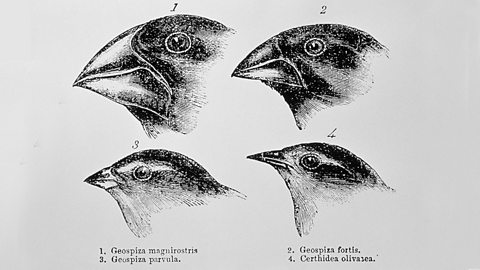Darwin and Wallace
The role of Wallace in developing the theory of evolution by natural selection

Alfred Russel Wallace was a great admirer of Darwin and a fellow naturalist. After a variety of zoological discoveries Wallace proposed a theory of evolution, which matched Darwin's unpublished ideas that he had kept secret for nearly 20 years. This encouraged Darwin to collect his scientific ideas and collaborate with Wallace. They published their scientific ideas jointly in 1858.
This also prompted Darwin to publish his book, 'On the Origin of Species', the following year. This meant that Darwin and Wallace worked together to improve the explanation of natural selection.
Wallace worked around the world gathering evidence to support the theory of evolution. He is best known for studying warning colouration in animals, including the Golden Birdwing Butterfly (Ornithoptera croesus) and his theory of speciationThe formation of new and distinct species in the course of evolution..
Speciation
Alfred Wallace created pioneering work in speciation. However, additional evidence over time has led to our current understanding of the theory.
A species is a group of organisms able to interbreed and produce fertile offspring.
New species can arise as a result of the following things:
- Genetic variation - each population has a wide range of allelesDifferent forms of the same gene. that can control their characteristics.
- natural selectionThe natural process whereby the best-adapted individuals survive longer, have more offspring and thereby spread their characteristics. Sometimes referred to as 'survival of the fittest'. - the alleles which help an organismLiving entity, eg animals, plants or microorganisms. to survive are selected in each population, which means they will be passed on to offspring.
Speciation is where populations become extremely varied and they can no longer interbreed to produce fertile offspring. They are classed as different species.
- Two populations of a species can become geographically separated because of the environment, for example a river separates a field into two areas.
- Isolation prevents interbreeding between the two populations meaning the combination of genes within the individuals in these populations changes.
- Different mutationA random and spontaneous change in the structure of a gene, chromosome or number of chromosomes. can take place in each of the isolated groups and create different phenotypeThe visible characteristics of an organism which occur as a result of its genes. within each particular location.
- Over time the individuals in each isolated population evolve to be so different to each other, that they can no longer interbreed to produce fertile offspring.
The diagram illustrates what could happen to an animal population, which is separated into two isolated groups by a geographical feature, such as a mountain or river.
Darwin and speciation
Charles Darwin described the speciation of finches after his studies of the birds on the Galapágos IslandsIslands in the Pacific Ocean, visited by Charles Darwin.. Darwin noticed that the finches on the different islands were similar to each other, but not exactly the same.

Darwin's observations revealed that the finches had wide variations in their size, beaks and claws depending on which island he was studying. The finches' beaks differed depending on the local food source.
Darwin concluded that because the islands were distant from the mainland, the finches that had arrived there had changed over time, adapting to the environment on each island. This isolation of individuals of the same species had led to new species developing.